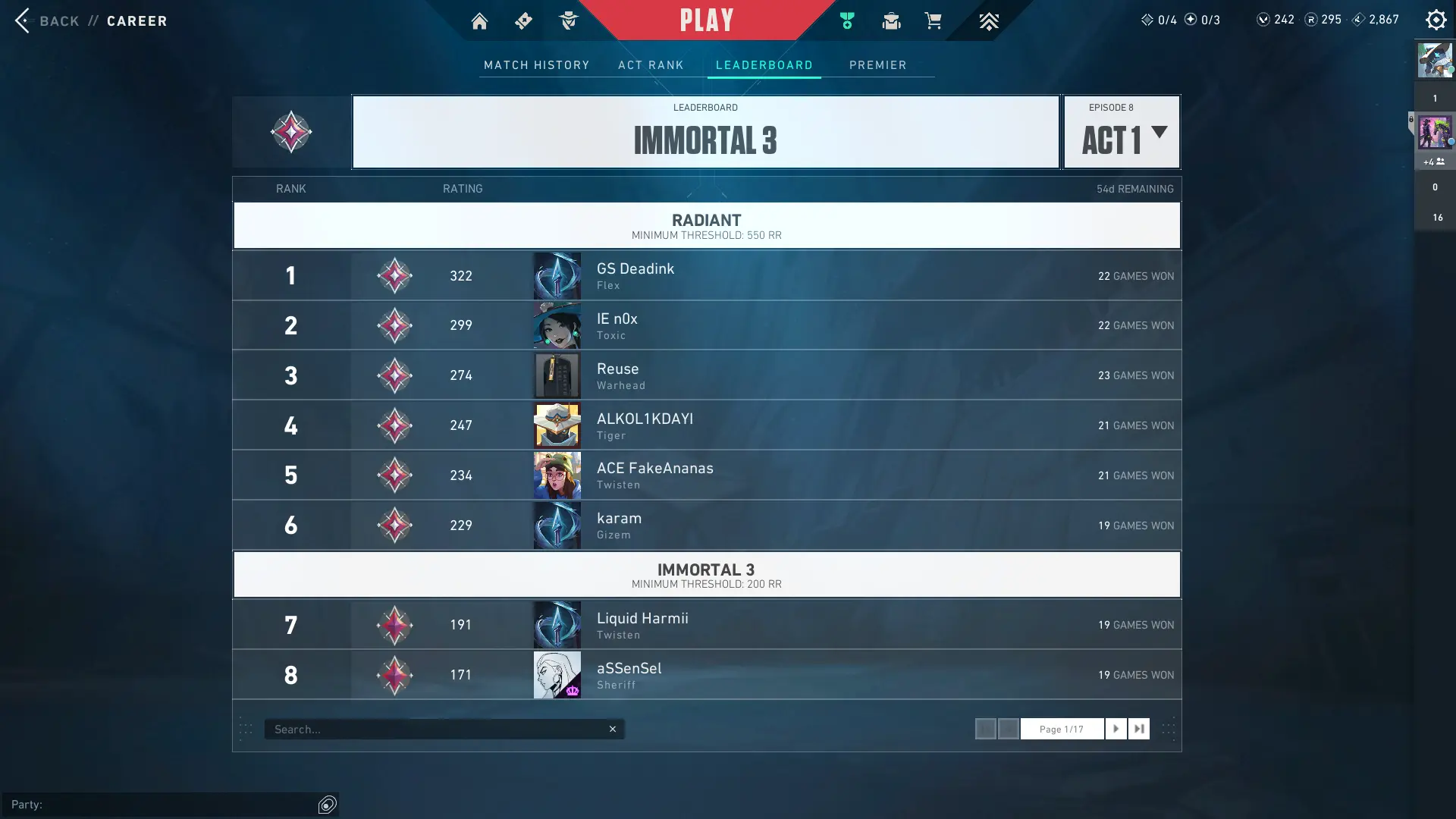
Valorant는 Riot Games가 개발한 전술적 1인칭 슈팅 게임으로, 각기 다른 이야기와 매력을 지닌 독창적인 게임 캐릭터들로 게이머들을 놀라게 했습니다. 플레이어들이 몰입하고 개선에 도전하도록 유지시키는 게임의 핵심 요소 중 하나는 Competitive 모드입니다. bo3 편집 팀은 Valorant의 Competitive 모드에 관한 상세 가이드를 준비하였으며, 이 모드가 어떻게 작동하는지, 플레이어가 영광의 길을 올라가는 동안 무엇을 기대할 수 있는지, 초심자와 숙련된 플레이어 모두에게 유용한 정보를 제공합니다.
Valorant의 Competitive 모드

Competitive 모드는 공정하고 흥미로운 게임 플레이를 보장하는 게임의 중요한 요소입니다. 거의 동일한 실력의 10명의 플레이어가 한 경기에 짝지어지고, Valorant Competitive가 어떻게 작동하는지 알아보려면 이 자료를 계속 읽으십시오. 게다가 이 모드는 대부분의 플레이어에게 게임으로 돌아와 기술을 향상시키려는 강력한 동기부여를 제공합니다. 여기서 여러분은 자신의 진행 상황을 추적할 수 있으며, 등급을 올리고 리더보드의 상위에 올라갈 수 있습니다. 이 리더보드는 게임 내에서 표시되며, 모든 플레이어가 확인할 수 있습니다.
Valorant에서 Competitive 모드 잠금 해제 방법

Valorant에서 Competitive 모드를 플레이하려면 이 모드를 잠금 해제해야 합니다. 이를 위해 플레이어는 게임 계정 레벨 20에 도달해야 합니다. 이는 현재 게임 기술을 평가하고 더 공정한 상대 매칭을 위해 등급을 공정하게 판단하는 단계입니다.

Competitive 모드의 작동 원리

Competitive 모드의 작동 방식, 잠금 해제부터 보상까지 모든 세부사항을 살펴보고, 이 모드가 어떻게 작동하는지 이해합시다.
- 등급 결정. 플레이어는 다른 모드에서 충분한 게임을 플레이한 후 Competitive에 참여할 수 있는 가능성을 열어야 합니다. 이후 이 모드에서 추가로 5번의 경기를 플레이해야 하며, 이 경기들을 기반으로 등급이 결정됩니다. Valorant Competitive 등급 시스템에 대해 더 알고 싶으시다면 아래의 다른 기사에서 확인하세요.
- 공정한 상대 매칭. 첫 경기와 등급을 받은 후, 매치메이킹 시스템은 플레이어의 실력을 고려하여 팀원과 상대를 선택합니다. 이 접근 방식은 Valorant 게임을 더 흥미롭게 만들고 플레이어가 기술을 개발하도록 장려합니다.
- 경기. Valorant의 Competitive 모드 규칙은 Unrated 모드와 약간 다릅니다. 게임은 한 팀이 13라운드를 이길 때까지 계속됩니다. 12:12 스코어가 나오면 승자가 정해질 때까지 연장전으로 들어가거나 플레이어들이 무승부에 동의합니다. 경기에 사용되는 맵은 Unrated와 동일하지만, 맵 풀은 약간 다릅니다; 현재 맵 목록을 알고 싶으시다면 이 자료를 계속 읽어보세요.
- 게임 후 등급 배분. Valorant의 Competitive 모드의 특징은 경기 결과가 등급에 영향을 미친다는 점으로, 이는 플레이어들이 더 집중하고 승리에 동기를 부여받도록 합니다. 승리 후, 플레이어는 경기 중 성과에 따라 10에서 45 포인트를 받습니다. 평균은 주로 23-25 사이입니다. 패배하면 등급이 차감됩니다.
- 보상. Ranked를 플레이하면 플레이어는 수집 아이템을 위한 좋은 보상을 받을 수 있습니다. Competitive 모드는 에피소드로 나뉩니다. 각 에피소드는 세 개의 액트로 구성되며, 처음 두 액트 동안 플레이어는 그 액트에서 가장 높은 등급의 상징이 있는 열쇠고리를 받습니다. 에피소드가 끝나면 전체 에피소드에서 가장 높은 등급의 열쇠고리를 받습니다.
등급을 올리기 위해 존재하는 다양한 등급을 이해해야 합니다. 이를 위해, 우리는 Valorant의 모든 등급을 자세히 설명한 또 다른 기사를 마련했습니다.
더 읽기: Valorant의 모든 등급
Competitive 매치를 승리하는 방법?

Valorant의 Competitive 매치에서 승리하기 위해서는 뛰어난 사격 및 반응 능력뿐만 아니라 전략적 사고, 팀워크, 요원 및 맵에 대한 지식이 필요합니다. 아래는 Valorant Competitive에서 승리 확률을 높일 수 있는 몇 가지 팁입니다.
- 의사소통: 마이크나 채팅을 사용하여 팀과 소통하고, 중요한 정보를 전달하며 전략을 제안하세요. 부정적이거나 독성이 있는 플레이어는 좋지 않은 평가를 받으며, 이런 사람들은 제재를 받습니다.
- 맵 지식: 활동 중인 맵 풀을 철저히 연구하면 게임 이벤트를 더 잘 이해하고 자세한 정보를 제공하는 데 도움이 됩니다. 또한 다양한 능력을 효과적으로 사용하는 방법을 넓힐 수 있습니다.
- 팀 협력: 팀으로 플레이하는 것은 Valorant에서 매치 전략을 개발하는 데 핵심 요소입니다. 팀과 상호작용하고, 서로를 도우며, 긍정적이고 경쟁적인 분위기를 유지하는 법을 배우십시오.
- 자신의 역할 수행: 모든 책임을 한꺼번에 맡을 필요는 없습니다. 미리 자신의 역할과 요원을 선택하고 필요한 업무를 수행하십시오.
- 능력의 효과적 사용: 캐릭터의 고유 능력을 능숙하게 사용하세요. 이러한 능력의 효과적인 사용은 여러 번의 승리를 가져다줄 수 있습니다.
이 팁들을 연습하면 등급을 올리고 게임뿐만 아니라 Valorant에서의 업적도 즐길 수 있습니다.
Valorant Competitive 맵 풀

Riot Games는 활동 중인 맵 풀에 7개의 맵을 지속적으로 유지하기 위해 노력하며, 새로운 맵이나 개선된 맵이 출시될 때 하나 또는 두 개의 맵을 교체합니다. 최근의 회전으로 Haven이 Icebox로 대체되었습니다. 아래에는 Valorant의 Competitive에서 사용되는 활동 중인 맵 풀을 소개합니다.
- Ascent
- Bind
- Breeze
- Icebox
- Lotus
- Split
- Sunset

Valorant의 Competitive 게임은 얼마나 오래 진행되나요?
경기를 시작하기 전에 얼마나 오랜 시간이 걸릴 수 있는지 이해하는 것이 중요합니다. 다른 일을 해야 하는 중에 여전히 게임에 있을 때 오해를 피하기 위해서입니다. Valorant에서 Competitive 경기는 20분에서 80분까지 진행될 수 있으며, 평균적으로 44분에서 52분의 지속 시간을 가집니다.
오랫동안 Competitive를 플레이하지 않으면 Valorant에서 내 등급에 무슨 일이 발생하나요?

Valorant에서 두 주 동안 Competitive 매치를 플레이하지 않으면 등급이 숨겨집니다. 이를 복원하려면 단 한 경기를 플레이하면 됩니다. 경기 후, 이전 등급과 거의 차이가 없는 등급이 부여됩니다. 차이는 이 경기의 결과인 승패에 달려 있습니다.
설명된 Valorant 등급 메커니즘과 주요 원칙들을 고려할 때, 이는 게임에서 가장 뛰어난 모드이며, 플레이어들이 발전하고 최고를 달성하기 위해 게임으로 돌아오도록 돕는 상황에서 인기를 누리는 이유입니다. 이 자료를 읽고 나서 모든 질문에 대한 답을 찾으셨기를 바랍니다.
댓글
다가오는 주요 경기
최신 주요 기사







아직 댓글이 없습니다! 첫 번째 반응을 남겨보세요